Rare Books: A Glossary
Cancel – Cuneiform
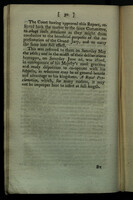
Cancel: A part of a book that has been substituted for what was initially printed (which is called a “cancelland”). Cancels are often signaled by the presence of a stub from where the cancelland was cut out of the book. Sometimes cancels are pasted directly onto the stub and sometimes they are tipped into the book. Bibliographers with a predeliction for Latin jargon may call the cancel a “cancellans” and the cancelland a “cancellandum.” A mnemonic device you may find helpful: the “cancelland” is larger and then part of it is taken away so that a “cancel” can be inserted in its place.
Image: Justice of Middlesex. A letter to a member of Parliament containing a narrative of proceedings relative to His Majesty's proclamation. London: Printed for J. Robson and W. Clarke ... [and 4 others], 1788. DA538.A1 J8 1788
Cancel: A part of a book that has been substituted for what was initially printed (which is called a “cancelland”). Cancels are often signaled by the presence of a stub from where the cancelland was cut out of the book. Sometimes cancels are pasted directly onto the stub and sometimes they are tipped into the book. Bibliographers with a predeliction for Latin jargon may call the cancel a “cancellans” and the cancelland a “cancellandum.” A mnemonic device you may find helpful: the “cancelland” is larger and then part of it is taken away so that a “cancel” can be inserted in its place.
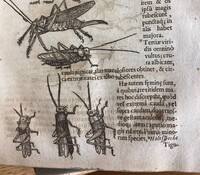
Casting off: A printing practice where compositors would estimate how many words would fit on a given page. This was important because few books were set in page order or even by the same compositor. Errors in casting off sometimes resulted in compositors having to alter the space between lines, resort to a smaller type, or sometimes even cannibalize the margins.
Image: Moffett, Thomas, 1553-1604, et al. Insectorum sive minimorum animalium theatrum. London: Thomas Cotes, 1634. QL463 .M93
Casting off: A printing practice where compositors would estimate how many words would fit on a given page. This was important because few books were set in page order or even by the same compositor. Errors in casting off sometimes resulted in compositors having to alter the space between lines, resort to a smaller type, or sometimes even cannibalize the margins.
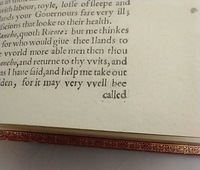
Catchword: A word printed on the bottom right-hand corner of a page that mirrors the first word on the following page. It served as an easy way to confirm that all of the pages were in the right order. The practice predated print but became common in the 1500s. French and German printers sometimes included catchwords only on the verso side and Parisian printers might only include them on the last page of a gathering. Catchword mismatches are often a sign that a page has been replaced with a cancel.
Image: Cervantes Saavedra, Miguel de, 1547-1616. Don Quixote. 1a. parte. English. London: Printed for Edward Blounte, 1620. PQ6329 .A2 1620
Catchword: A word printed on the bottom right-hand corner of a page that mirrors the first word on the following page. It served as an easy way to confirm that all of the pages were in the right order. The practice predated print but became common in the 1500s. French and German printers sometimes included catchwords only on the verso side and Parisian printers might only include them on the last page of a gathering. Catchword mismatches are often a sign that a page has been replaced with a cancel.
![The Principal errors of the Church of Rome examined and refuted : in fifteen sermons preached at Salter-Hall, 1735 / By the Reverend Mr. Barker ... Mr. Neal ... [and others]. The Principal errors of the Church of Rome examined and refuted : in fifteen sermons preached at Salter-Hall, 1735 / By the Reverend Mr. Barker ... Mr. Neal ... [and others].](https://library.missouri.edu/specialcollections/files/thumbnails/1bd4941d9ce6dbb944abfad064122747.jpg)
Chain lines: The thicker of the two types of lines found in laid paper. Chain lines are parallel to the shorter edge of a sheet of paper and are often accompanied by a shadow from the ribs of the papermaker’s mold. These lines, like the thinner wire lines, are easiest to spot when light shines through the sheet of paper. Identifying the orientation of a paper’s chain-lines can serve as a clue to its format since they indicate how the sheet was folded. Chain and wire lines disappeared after the invention of wove paper in the mid-18th century.
Image: The Principal errors of the Church of Rome examined and refuted in fifteen sermons preached at Salter-Hall, 1735. London, 1735. BX1763 .P7 1735
Chain lines: The thicker of the two types of lines found in laid paper. Chain lines are parallel to the shorter edge of a sheet of paper and are often accompanied by a shadow from the ribs of the papermaker’s mold. These lines, like the thinner wire lines, are easiest to spot when light shines through the sheet of paper. Identifying the orientation of a paper’s chain-lines can serve as a clue to its format since they indicate how the sheet was folded. Chain and wire lines disappeared after the invention of wove paper in the mid-18th century.
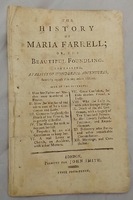
Chapbook: A small pamphlet, typically containing popular, sensational, juvenile, moral, or educational materials. Chapbooks were initially sold not by established booksellers but by itinerant peddlers called chapmen (hence the name). They faded out of use in the 1830s.
Image: The History of Maria Farrell, or, The beautiful foundling. London: Printed for John Smith, 1780. PR3991.A1 H57 1780
Chapbook: A small pamphlet, typically containing popular, sensational, juvenile, moral, or educational materials. Chapbooks were initially sold not by established booksellers but by itinerant peddlers called chapmen (hence the name). They faded out of use in the 1830s.

Codex: A book form consisting of gatherings that have been sewn together at the fold. Codices usually also have been bound and provided with protective covers. The codex probably evolved during in the first century CE from the reusable wax tablets used by the Greeks and Romans. Christians were early adopters of the codex form and spread it throughout Europe, eventually making it the dominant book form of Europe, to the point that “codex” and “book” are often used interchangeably even though a codex is a specific type of book.
Image: Parkinson, John, 1567-1650. Theatrum botanicum : the theater of plants, or An Herball of large extent. London: Thomas Cotes, 1640. QK41 .P2
Codex: A book form consisting of gatherings that have been sewn together at the fold. Codices usually also have been bound and provided with protective covers. The codex probably evolved during in the first century CE from the reusable wax tablets used by the Greeks and Romans. Christians were early adopters of the codex form and spread it throughout Europe, eventually making it the dominant book form of Europe, to the point that “codex” and “book” are often used interchangeably even though a codex is a specific type of book.
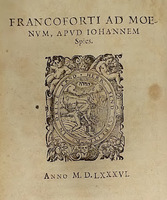
Colophon: A note at the end of a book that includes some or all of the following: the title, the author, the printer, the place of printing, and/or the date. Like many printing conventions, this one also derives from manuscripts: many rubricators signed their work and provided similar information. The first printed colophon was in the Mainz Psalter, printed by Johann Fust and Peter Schöffer in 1457. Colophons often include a printer’s device or logo as well. Eventually, the information in the colophon migrated to the title page.
Image: Aristophanes. Nicodemi Frischlini Aristophanes, veteris comoediae princeps; poeta longe facetissimus & eloquentissimus. Frankfurt: Johann Spies, 1586. PA3875 .A28 F75 1586
Colophon: A note at the end of a book that includes some or all of the following: the title, the author, the printer, the place of printing, and/or the date. Like many printing conventions, this one also derives from manuscripts: many rubricators signed their work and provided similar information. The first printed colophon was in the Mainz Psalter, printed by Johann Fust and Peter Schöffer in 1457. Colophons often include a printer’s device or logo as well. Eventually, the information in the colophon migrated to the title page.
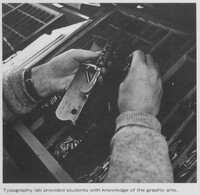
Compositor: A worker in a print shop whose responsibility is arranging type into words. During the hand press era (roughly 1454 to 1800), this was done manually: the compositor would take individual letters out of their respective cases and form them into a row of words on a composing stick. These could then be transferred to the press. With the invention of machines like the Monotype and Linotype in the late 19th century, this process became automated. Compositors are sometimes also called “typesetters.”
Image: Savitar. Columbia: University of Missouri, 1969. LH1 .S2 v. 75 1969. Digitally available at the MU Digital Library.
Compositor: A worker in a print shop whose responsibility is arranging type into words. During the hand press era (roughly 1454 to 1800), this was done manually: the compositor would take individual letters out of their respective cases and form them into a row of words on a composing stick. These could then be transferred to the press. With the invention of machines like the Monotype and Linotype in the late 19th century, this process became automated. Compositors are sometimes also called “typesetters.”

Coptic binding: A binding style practiced by native Egyptian Christians. Coptic bindings are the earliest known bindings of the codex format. Coptic binding does not usually use sewing supports, instead just stitching each gathering to the ones preceding and following it. Famously, many Coptic bindings do not have spine coverings, leaving the sewing and folds exposed.
Image: Aly, Islam. The square. Iowa City: Islam Aly, 2014. N7433.4.A49 S68 2014
Coptic binding: A binding style practiced by native Egyptian Christians. Coptic bindings are the earliest known bindings of the codex format. Coptic binding does not usually use sewing supports, instead just stitching each gathering to the ones preceding and following it. Famously, many Coptic bindings do not have spine coverings, leaving the sewing and folds exposed.
Countermark: A second watermark that often serves to indicate the papermaker’s identity. Countermarks commonly include the date, though one should be careful about trusting it: a 1741 French law requiring all French papermakers to include a date in their countermarks failed to specify that the date had to change or be accurate. Many papermakers were quick to exploit the loophole and simply used 1742 as their date for several years.
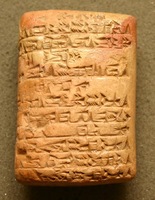
Cuneiform: A writing style used in ancient Mesopotamia. Cuneiform was written using a reed or stylus to make wedge-shaped impressions in wet clay, which could then either be dried in the sun or a kiln. Cuneiform was invented by the Sumerians, taking on its characteristic form in 2800 BCE, and was adopted by several cultures with the last known cuneiform inscription dated to 75 CE. The vast majority of surviving cuneiform inscriptions are either economic or administrative in nature.
Cuneiform: A writing style used in ancient Mesopotamia. Cuneiform was written using a reed or stylus to make wedge-shaped impressions in wet clay, which could then either be dried in the sun or a kiln. Cuneiform was invented by the Sumerians, taking on its characteristic form in 2800 BCE, and was adopted by several cultures with the last known cuneiform inscription dated to 75 CE. The vast majority of surviving cuneiform inscriptions are either economic or administrative in nature.